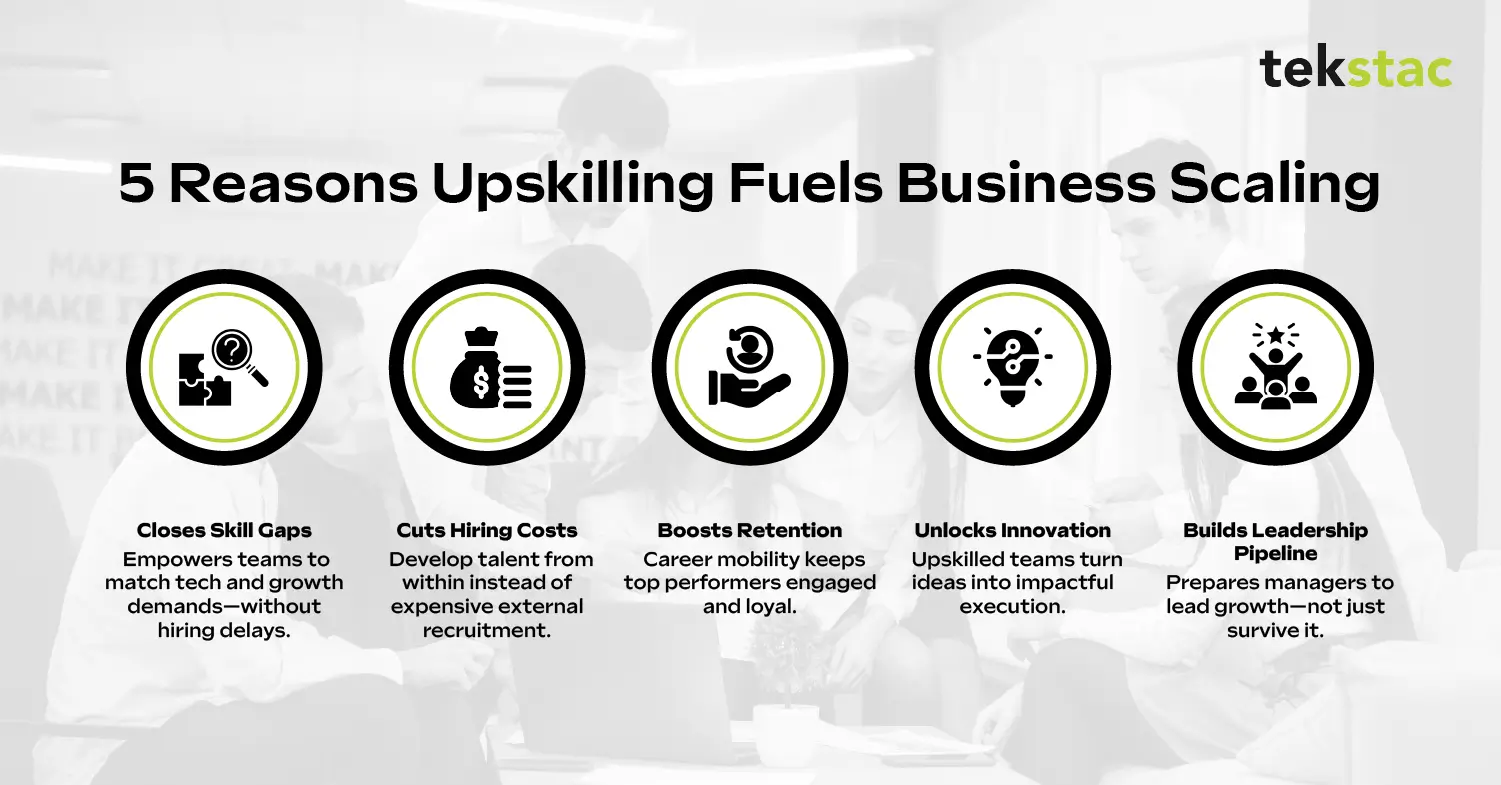5 Reasons Employee Upskilling Is the Key to Business Scaling in 2025

Scaling a business in 2025 demands a workforce ready to meet new challenges. Yet, many companies hit a hard wall not because of market limits, but due to a growing skills gap within their own teams.
According to a 2023 report by IBM, organizations that prioritize employee upskilling experience a 22% increase in revenue growth compared to those that don’t. This shows that investing in employee skills is one of the core engines beyond sustainable business scaling. In this blog, we’ll break down why workforce development is important for business scaling, and how they’re connected.
Why is Employee Upskilling Central to Business Scaling
Generally, business scaling is often associated with expanding business operations, entering new markets, or increasing production. However, what we miss is that behind every successful scale-up lies a workforce capable of handling that growth. This is exactly where employee upskilling becomes indispensable.
Employee upskilling refers to the process of equipping employees with additional skills to help them perform better in their current roles, while preparing for future responsibilities. Unlike reskilling, which is about training people for entirely new roles, upskilling focuses on depth over direction. It increases internal capability rather than replacing it.
So, how does this matter for business scaling? Business scaling is something that requires faster decision-making, stronger collaboration, and adaptive leadership. Without investing in your people’s ability to meet those demands, it can become difficult to scale your business effectively.
Let’s take a simple example. If we say a mid-sized SaaS company is looking to serve enterprise clients. Their product roadmap would scale, and so do their expectations around security, analytics, and implementation timelines. If the customer success team hasn’t been upskilled on enterprise onboarding protocols or strategic account management, the scale breaks with roadblocks, ultimately leading to churn and declined revenue. Now, if we multiply that across departments, like sales, marketing, tech, or support, it becomes clear that scaling a business requires scaling your people.
This isn’t a theoretical idea. According to LinkedIn’s 2024 Workplace Learning Report, companies that embed upskilling into their core business strategy are 57% more likely to see higher employee retention, 23% more internal mobility, and 7% stronger management pipelines.
5 Reasons Employee Upskilling Is the Key to Business Scaling
For decades, we’ve seen business scaling be a numbers game, including customers, bigger budgets, and expanded product lines. This traditional mindset focuses on external growth factors and ignores internal driver, which is the capabilities of the workforce itself.
Below, let’s explore the five reasons why employee upskilling is the key to scaling your business effectively in 2025.

1. Closes Critical Skill Gaps That Stall Growth
Sometimes, companies may fail to scale as desired because their teams can’t keep pace with the scale they’re chasing. Quick digital transformations, new tools, and changing customer expectations demand new skill sets that the current workforce may not have. Workforce development closes this gap from the inside out. Instead of pausing to hire new talent for every emerging need, which is slower and costlier, companies can level up their existing teams to meet any new challenges.
2. Reduces Dependence on Costly External Hiring
Business scaling often tempts leaders to throw headcount at a problem. However, aggressive hiring during growth stages can lead to bloated teams, rising overheads, and misaligned talent. Hence, employee upskilling offers a more sustainable path.
When you develop existing employees into higher-impact roles, you retain organizational knowledge and culture, which are two assets that cannot be replaced with new hires. More importantly, it’s cheaper. Recruiting, onboarding, and ramping a new employee to productivity can cost 3 to 4x more than developing one internally.
LinkedIn’s Workplace Learning report found that organizations with solid internal mobility programs see twice as long employee retention than those with low mobility. Hence, upskilling builds from within, so you don’t constantly build from scratch.
3. Strengthens Retention by Creating Career Mobility
Most times, top talent quits because they feel stuck in their roles. LinkedIn reports that 94% of employees would stay longer at a company that invests in employee learning and development. A lack of employee development opportunities is one of the top reasons high performers walk away, especially in growing companies where roles change quickly but careers don’t.
Intentional workforce development provides employees a clear career path forward, showing them that there’s a future in the company beyond their current title. This directly improves retention, stability, and morale, all of which are extremely essential when your business is scaling and cannot afford churn.
4. Unlocks Innovation from Within
The teams closest to your customers, products, and systems often hold the most valuable insights. If they lack the skills to execute new ideas, those insights stay untapped. With proper upskilling, they can turn their knowledge into innovation.
Be it via training a support team in data analytics to find product bugs or coaching marketers on new AI tools to scale campaign testing, such small skill upgrades lead to big business advantages. Hence, it’s important to remember that you don’t always need to hire innovation, most times you just need to unlock it.
5. Builds the Leadership Pipeline Required for Long-Term Scaling
Companies can scale faster than their leadership capacity. This means they hire faster than they promote, and grow functions but not managers. And eventually, they hit a wall—not because of market failure—because of management failure. Thorough upskilling prepares mid-level managers to lead at scale. It provides new leaders with the decision-making, communication, and strategic thinking skills to handle challenges. Without this, business scaling may crumble under pressure. They say they face leadership gaps that directly impact business growth. Scaling may add people, but it must multiply leaders as well.
How to Build an Upskilling Program That Accelerates Business Scaling
Scaling a business without a structured employee upskilling strategy can prove to be ineffective. To create a workforce that also grows with your business goals, upskilling must be intentional, tied to business goals, and deeply rooted in the company’s culture.
Let’s see below how you can do it right:
1. Start with a Strategic Skills Audit
Before rolling out any programs, map your current capabilities against the future needs of the business. Look at two important things:
- What skills are missing in your teams today?
- What skills are important for tomorrow’s goals?
You can use internal performance data, manager feedback, and tools like skill assessments or 360-degree reviews to find skill gaps in both hard and soft skills. For instance, if your product roadmap is expanding into AI-based features, your customer support and marketing teams may need technical understanding in machine learning concepts, even if they’re not coding themselves.
2. Tie Upskilling Directly to Business Objectives
Upskilling must always directly support business revenue, product, or scaling goals. For example,
- If you’re scaling into new markets, train sales teams on cross-cultural negotiation
- If you’re launching a new product line, upskill managers on agile delivery or cross-functional collaboration
When learning programs are clearly tied to business outcomes, leaders buy in faster and employee see the value of upskilling programs.
3. Use Blended Learning Methods That Fit Your Team
Everyone learns differently, hence the most effective upskilling programs combine formal and informal methods, such as:
- Microlearning for quick, focused lessons
- Peer coaching or internal mentorship
- Workshops or real-time simulations for hands-on practice
- Online academies, like LMS platforms or certifications, for depth
4. Embed Upskilling into Daily Culture
Make development a shared responsibility between the company, manager, and the employee. This means ensuring regular development check-ins, celebrating learning wins, and so on. This transformation starts by changing development from being the sole responsibility of a single department:
- Organizations must create an environment that prioritizes learning as a strategic requirement
- Managers must bridge the role between strategy and execution
- Employees must take ownership of their own development
5. Measure the Business Impact
To scale sustainability of the learning program, you need to connect learning outcomes. Ask:
- Did productivity improve?
- Did project delivery speed up?
- Did collaboration or customer satisfaction improve?
These are the signals that tell you whether your employee upskilling strategy is enabling business scale.
Powering Scalable Upskilling with the Right Infrastructure
Delivering an upskilling strategy at scale across departments, roles, and learning needs is a huge challenge. Organizations may struggle with execution at the time of business scaling because they lack the infrastructure to support personalized learning at speed. Managing multiple learning paths, tracking progress across teams, ensuring assessment integrity, and keeping programs aligned with business goals require an end-to-end platform, such as Tekstac.
A solution like Tekstac is built specifically for scaling upskilling efforts. It enables you to:
- Access 500+ curated learning paths across high demand domains like data analytics, cloud, cybersecurity, and more
- Deliver hands-on practice through sandbox lab environments, helping employees apply concepts in their work
- Make use of fine-grained assessments, AI-proctored tests, and video-based evaluations to ensure knowledge retention
- Gain real-time visibility into learning progress and capabilities through interactive dashboards and predictive analytics
- Customize programs with virtual sessions, mentor support, and business-aligned interventions, be it for new joiners or experienced teams
Ready to connect learning with business outcomes? Explore how Tekstac is helping global teams grow faster, smarter, and at scale.






This blog powerfully highlights how upskilling directly fuels sustainable growth. It’s true—scaling a business means scaling your people first. Skill development isn’t optional—it’s the foundation of future-ready teams!